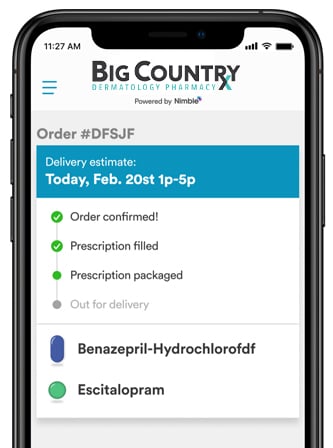Self-pay pricing varies a great deal from pharmacy to pharmacy. It can be based on a huge number of different factors, from cost, to likeliness of driving future business, to expiration dating, to normally reimbursement rates of insurance companies.
It is important to know that, in many cases, a patient can even be better off not using their insurance and instead use a self-pay program at a pharmacy. This is especially true in dermatology, where many medications are categorized as a cosmetic need and not an actual medical need.
This is why a patient needs to better understand the options that are available to them so that they know what pharmacy to go to for their medication.
Read More
Topics:
dermatology,
prescription,
medication,
compounds,
Counseling Corner,
self-pay,
pricing
Dermatologists often prescribe the active ingredients that you find in our Triple Lightening cream to treat uneven skin tone and pigmentation caused by sun exposure or hormonal changes, or possibly to improve the appearance of acne scars. Our triple lightening cream consists of a steroid, which is either triamcinolone or hydrocortisone, hydroquinone, a bleaching agent, and tretinoin, which is a retinoid that helps bring skin cells to the surface.
Read More
Topics:
dermatology,
prescription,
medication,
compounds,
Counseling Corner,
cream,
triple,
lightening
In today’s pharmaceutical world, there are many commercial drugs available to treat all kinds of conditions. This leads to many patients wondering why they need a compounded medication if there are so many other commercially available and mass manufactured medications that could treat their condition?
The short answer to this question is, if the more commercially available medication is able to better treat their condition, then they should definitely use that medication. Most providers prescribe ten or 20 times more commercially made medications than compounded ones for this same reason. But what happens when there is no commercially available medication to treat their condition? This is when a patient should use a compounded medication.
Read More
Topics:
dermatology,
prescription,
medication,
compounds,
Counseling Corner
Here at claRx Big Country Dermatology Pharmacy, we offer a variety of wart peel products. Our wart peels come in cream, ointment, and liquid formulations. Most wart peel products contain salicylic acid, which softens the skin cells and leads to peeling. They usually contain fluorouracil, which works by interfering with cell DNA, which leads to cellular death in the targeted area. Some of the wart peel ointments contain podophyllin, which interferes with cell division and the formation of new wart skin cells.
Read More
Topics:
dermatology,
prescription,
medication,
compounds,
Counseling Corner,
wart,
peel
Fluorouracil is a topical chemotherapy agent that is typically used to treat precancerous cells for people with actinic keratosis or basal cell carcinomas. It is manufactured under the brand names Efudex and Carac.
Read More
Topics:
dermatology,
medication,
compounds,
Counseling Corner,
fluorouracil
Isotretinon is an oral retinoid that is derived from Vitamin A and is commonly used as the last option to treat severe acne that hasn’t responded to other treatments. It is manufactured under the trade names Absorica, Absorica LD, Myorisan, Zenatane, Claravis, and Amnesteem.
Read More
Topics:
dermatology,
medication,
Counseling Corner,
isotretinoin
Topical retinoids are used in the treatment of acne, fine wrinkles, and to improve the overall appearance of your skin. There are many medications in this class, including tretinoin (brand names: Altreno, Renova, and Retin-A), tazarotene (brand names: Tazorac, Fabior, and Arazlo) and adapalene (brand name: Differin). Combination products that contain topical retinoids include Epiduo and Epiduo Forte (adapalene + benzoyl peroxide), Duobrii (tazarotene + halobetasol), Veltin and Ziana (tretinoin + clindamycin) and Tri-Luma (tretinoin + hydroquinone + fluocinolone).
Read More
Topics:
dermatology,
medication,
Retinoid,
Counseling Corner
A key part of the compounding process is the method chosen to mix the medication. There are several processes used by pharmacies to create topical compounds. The 3 primary options we are reviewing are the traditional mortar and pestle, the electronic mortar and pestle, and the planetary mixer. In order to better understand and appreciate the planetary mixer, you have to first know about the more common compounding methods used by most compounding pharmacies.
Read More
Topics:
dermatology,
compounding,
dermatology equipment
Compounding medication in pharmacy has been done for hundreds of years. You can even say thousands of years depending on how you view the process. While compounding itself may not be new, we continually improve our processes using the most up to date methods and equipment. Today we want to help you understand the process of actually creating a compound from start to finish. To do that, we will go through the steps of creating a compound and some of the details along the way.
Read More
Topics:
dermatology,
compounding,
process
There are at least 35 options to decide from once a provider decides Tetracycline is the best treatment at that time for the patient. 35! What happened to the days when there were only 1 or 2 drug choices in a class? And 1 or 2 different strengths or release mechanisms? Well, those days are long gone.
Read More
Topics:
Tetracycline,
Proven Process,
Acne Treatment,
Provider Protocols



